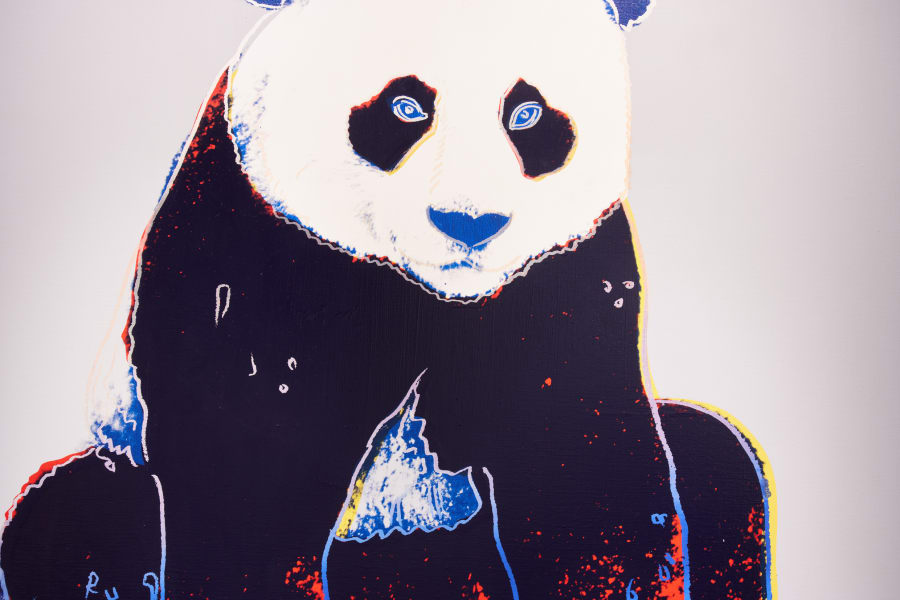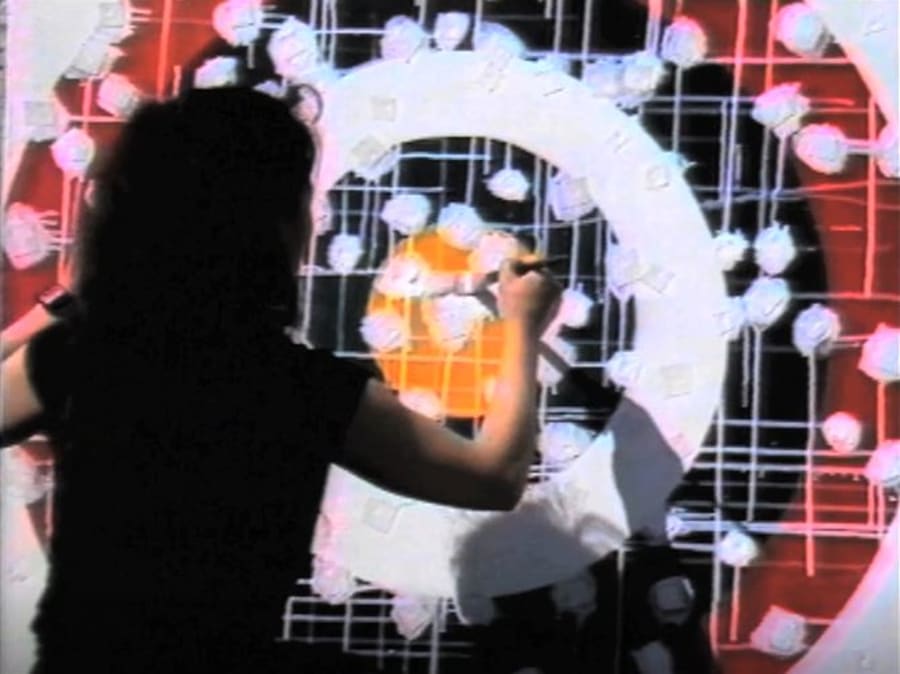What should everyone have in their bag when visiting an art fair?
Amanda Love: I prefer not to have a bag as it makes for a more seamless entry since there is no need to check anything in. I suggest keeping your essentials in your pockets, such as your phone with a map marked up with your initial route, wipes to cater for the constant hand shaking, and Listerine breath strips as a lot of talking and kissing goes on too.
William Zhao: You definitely need your phone. The Hong Kong fair is so big now so you need to concentrate. I suggest eating a big brunch so you can skip lunch. Carry some chocolate and water with you and prepare to walk for several hours.
What would you recommend to those visiting Art Basel Hong Kong for the first time?
AL: Pace yourself! The program is always comprehensive and it’s also full-on. I try to get there the day before and see as many exhibitions as possible before the crowds arrive; the lift situations on opening nights can be challenging.
WZ: It’s worth staying in the city for at least four days or even a week. Since COVID-19, there’s been a huge change in the cultural scene in Hong Kong. The M+ museum has opened and Tai Kwun [an art center in a former Central Police Station compound] has a fantastic program. There are a lot of really dynamic young Hong Kong galleries like Kiang Malingue. They have a beautiful new building in the Wan Chai area. Another really young, and very interesting gallery is PHD Group which has a rooftop space. They show some talented Hong Kong artists. It’s very avant-garde. And on the antiquities side, we have the Hong Kong Palace Museum.
Which artists and galleries are you most looking forward to discovering at the 2024 edition?
AL: I’m very much looking forward to seeing the offsite work presented in Pacific Place mall as part of Encounters, by the indigenous Australian contemporary artist Daniel Boyd, copresented by Station and Kukje Gallery. At the fair, there are Angela Tiatia and Naminapu Maymuru-White at Sullivan+Strumpf – the latter will be included in Adriano Pedrosa’s 2024 Venice Biennale. I love the work of Anne Imhof who will be showing with Sprüth Magers and then Cécile B. Evans at Layr. It will also be interesting to see the new work of rising star Loie Hollowell at Jessica Silverman. I’m also very much looking forward to seeing Yona Lee’s presentation at Fine Arts, Sidney.
WZ: I’m looking forward to seeing Greene Naftali’s solo booth of work by Jacqueline Humphries. I’d love to see P.P.O.W’s stand. They have the Estate of Martin Wong and also represent some excellent younger names. Antenna Space always has very creative artists like Xinyi Cheng. Another gallery from China is Vitamin Creative Space. They never send a preview of their booth ahead of the fair but they always have a fantastic presentation. Most galleries send out PDFs because they always want to sell in advance, but they are an exception and so their booth is a surprise which is really nice.
What galleries are you most looking forward to seeing in the city?
AL: I lived in HK in the late 1980s when it was pretty much a cultural desert except for the Fringe Club. I’m amazed and proud to see how much it has developed culturally. Infrastructure like Tai Kwun has been an essential element in this process. At the other end of the dial, I can’t wait to see Hauser & Wirth’s new gallery. As they have described it to me, the space promises to be pretty incredible – another quality element in the important cultural landscape of Hong Kong, and a vote of cultural confidence in the region as a whole.
WZ: Pace Gallery will show Kylie Manning’s work which I want to see. David Zwirner is showing Wolfgang Tillmans which is always good. For younger trendy artists there’s WOAW Gallery. I am particularly looking forward to visiting local spaces such as Empty Gallery and of course Blindspot Gallery, which takes a more academic approach. This is the second time in a row that the latter’s artists are showing at the Venice Biennale; this year Trevor Yeung will represent Hong Kong.
What are the most important factors when selecting artworks for a client?
AL: As a professional, I pride myself on being able to set aside my own taste and focus on what I understand as objectively important (i.e. good art) and identify what is not worth paying attention to (i.e. bad art). The goal is to pursue those good works, but also appeal to a client’s personal taste. These are the acquisitions that will take each person on a particular ‘art journey’ and hopefully, also increase their self-knowledge. I see my job as getting to know clients and understand their particular taste so I can help them tease out and develop their interests with works that will continue to speak to them over time. The goal is to build a collection which resonates with them personally and has art historical relevance.
WZ: What’s very important for me is authenticity. Artists should be 100% honest in their work and it should truly be a reflection of themselves. It should also be a good work. An artist may be talented but they can still make bad work. Finally, the artwork should be in the right hands so the gallery is important too. A good gallery is very protective of its artists and not just focused on commercial aspects.
Are there any differences when dealing with clients in Asia versus the West?
AL: Not that I have experienced, perhaps because of the way I prefer to work with clients.
WZ: Even with globalization, in the end you still have to keep in mind cultural nuances. For example, some Asian families still struggle a bit with nudity but maybe for Europeans or Americans that is easier to deal with. It’s difficult to generalize but it is important to keep in mind cultural differences.
What’s your advice on how best to discover the fair and the public program?
AL: Art Basel makes this pretty simple with its website; it’s accessible, comprehensive, and rigorous – a veritable smorgasbord. You can research well before the fair and book tickets so you have your program worked out ahead of time. It is also good to keep an eye on the Financial Times before the fair – they usually have a pretty comprehensive and insightful roundup.
WZ: Everyone visiting the art fair may be looking for something different. Personally, I circle all the galleries that I really want to focus on, visiting their booths within the first few hours. Then I come back to screen all the galleries again in case I missed something. In one or two days you may see the work of a thousand artists so you need time to digest it all. It’s good to come back later and take a second look at a work. If it talks to you and you still feel the same excitement, then you can move on from there. Even though it’s very competitive in an art fair and you may not be able to buy this particular artwork, at least you have found something good. It’s not only about acquiring work but it’s also about becoming informed or discovering artists you can follow in the future.
Could you share a secret of your profession?
AL: Education, honesty, and insight, coupled with a cast-iron constitution which enables constant information gathering (real-time and otherwise, locally and internationally). It’s about assessment, reassessment, and appraisal.
WZ: People may assume that you should be overly confident or even arrogant to thrive in the art world but I think we really need to be humble and curious. These are really useful qualities. It’s important to try to understand artists, for instance, even if they are new and green. If you are down-to-earth and open minded, you can learn something new.
After the fair, where do you stop for a drink or dinner with your clients?
AL: Drinks wise I can’t tell you that! It’s a tiny spot which is a true local secret. Dinner is often decided by invitations from others, which is always a treat. But if the invitation is mine, I still get a thrill from the rarefied air of Man Wah at the top of my spiritual home, the Mandarin Oriental. I was there to watch the Chinese People’s Liberation Army troops enter the city at a minute past midnight on July 1, 1997 [the date of the UK handover of Hong Kong to China] and I’ve returned to the restaurant most years since. Man Wah has reinvented itself a number of times, but without losing any of its excellence or relaxing charm.
WZ: To be honest during the fair I don’t go out for many dinners but I can give you some names. There’s a great French restaurant called Louise which uses local ingredients and has an amazing wine list. Another favorite is the Japanese restaurant Sushi Fujimoto; the chef comes from Sushi Saito, the famous restaurant in Tokyo. For drinks there’s COA cocktail bar near Hollywood Road which has a great ambiance and there is also a beautiful new bar on the roof of Landmark called Cardinal Point.
Art Basel Hong Kong will take place from March 28 to 30, 2024. Get your tickets here.
Payal Uttam is a journalist and critic who divides her time between Hong Kong and Singapore.
Caption for top image: View of Art Basel Hong Kong 2023.
Published on March 11, 2024.


